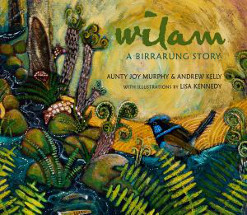Wilam: a Birrarung story by Aunty Joy Murphy

Illus. by Lisa Kennedy. Black Dog Books, 2019. ISBN: 9781925381764.
(Age: 4 - adult) Highly recommended. Themes: Yarra River, Melbourne,
Aboriginal history, Environment. The stunning acrylic illustrations
that cover every page will entice readers to pore over every detail,
looking out for examples of the environment through which the
Birrarung (Yarra) River flows from the mountains to the sea. Keen
eyes will spot birds and animals, trees and different forms of
forest, insects, flowering plants, houses, bridges and cities. The
river flows through all of these, wrapping itself around both the
modern world and the past, speaking for both cultures which inhabit
this place, joining them together in a way both startling and fresh.
Wilam (home) is home to all, and this inclusive story tells of the
river, encompassing everything and everybody along its shores.
Indigenous and non Indigenous people populate its banks, each as
proud as the other of the river and recognising it as home.
Some of the pages are framed with scenes from the modern world and
those of the past, reflecting Indigenous people and their skills,
linking them with modern skills shown by bridges and roadways. Told
in English and Woiwurrung the language of the Wurundjeri people of
the area now known as Melbourne, the authors, Aunty Joy Murphy and
Andrew Walker grew up in Wurundjeri country along the Birrarung
(Yarra) and both hold dear a responsibility towards this
environment. They worked with Lisa Kennedy, an illustrator working
out of Melbourne. Her links with the Marybyrnong River and its
reclamation are evident in the work she has done for this book,
highlighting the shared aspects of regeneration.
As Woiworrung words are used throughout the book, a wonderful
glossary ends the book, with a smaller version of each page given
with the words and their translation into English shown. Children
will readily accept the different words as they read, learning some
of the repeated words (Wilam, Birrarung, Waa and Warin, for example)
with ease.
This beautiful book adds to the growing number of books
encapsulating our Aboriginal heritage, demonstrating our shared
history and culture. Each page resonates with meaning, begging to be
looked at closely while pondering the enormous time span represented
by this river's being home to so many, in the past, now and into the
future. Teacher's
notes are available.
Fran Knight